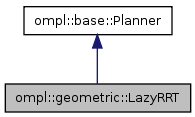#include <LazyRRT.h>

Classes | |
| class | Motion |
| Representation of a motion. More... | |
Public Member Functions | |
| virtual void | clear (void) |
| Clear all internal datastructures. Planner settings are not affected. Subsequent calls to solve() will ignore all previous work. | |
| double | getGoalBias (void) const |
| Get the goal bias the planner is using. | |
| virtual void | getPlannerData (base::PlannerData &data) const |
| Get information about the current run of the motion planner. Repeated calls to this function will update data (only additions are made). This is useful to see what changed in the exploration datastructure, between calls to solve(), for example (without calling clear() in between). | |
| double | getRange (void) const |
| Get the range the planner is using. | |
| LazyRRT (const base::SpaceInformationPtr &si) | |
| Constructor. | |
| void | setGoalBias (double goalBias) |
| Set the goal biasing. | |
| template<template< typename T > class NN> | |
| void | setNearestNeighbors (void) |
| Set a different nearest neighbors datastructure. | |
| void | setRange (double distance) |
| Set the range the planner is supposed to use. | |
| virtual void | setup (void) |
| Perform extra configuration steps, if needed. This call will also issue a call to ompl::base::SpaceInformation::setup() if needed. This must be called before solving. | |
| virtual bool | solve (const base::PlannerTerminationCondition &ptc) |
| Function that can solve the motion planning problem. This function can be called multiple times on the same problem, without calling clear() in between. This allows the planner to continue work more time on an unsolved problem, for example. If this option is used, it is assumed the problem definition is not changed (unpredictable results otherwise). The only change in the problem definition that is accounted for is the addition of starting or goal states (but not changing previously added start/goal states). The function terminates if the call to ptc returns true. | |
| virtual | ~LazyRRT (void) |
Protected Member Functions | |
| double | distanceFunction (const Motion *a, const Motion *b) const |
| Compute distance between motions (actually distance between contained states). | |
| void | freeMemory (void) |
| Free the memory allocated by this planner. | |
| void | removeMotion (Motion *motion) |
| Remove a motion from the tree datastructure. | |
Protected Attributes | |
| double | goalBias_ |
| The fraction of time the goal is picked as the state to expand towards (if such a state is available). | |
| double | maxDistance_ |
| The maximum length of a motion to be added to a tree. | |
| boost::shared_ptr < NearestNeighbors< Motion * > > | nn_ |
| A nearest-neighbors datastructure containing the tree of motions. | |
| RNG | rng_ |
| The random number generator. | |
| base::StateSamplerPtr | sampler_ |
| State sampler. | |
Lazy RRT.
Definition at line 81 of file LazyRRT.h.
| ompl::geometric::LazyRRT::LazyRRT | ( | const base::SpaceInformationPtr & | si | ) | [inline] |
| virtual ompl::geometric::LazyRRT::~LazyRRT | ( | void | ) | [inline, virtual] |
| virtual void ompl::geometric::LazyRRT::clear | ( | void | ) | [virtual] |
Clear all internal datastructures. Planner settings are not affected. Subsequent calls to solve() will ignore all previous work.
Reimplemented from ompl::base::Planner.
| void ompl::geometric::LazyRRT::freeMemory | ( | void | ) | [protected] |
Free the memory allocated by this planner.
| double ompl::geometric::LazyRRT::getGoalBias | ( | void | ) | const [inline] |
| virtual void ompl::geometric::LazyRRT::getPlannerData | ( | base::PlannerData & | data | ) | const [virtual] |
Get information about the current run of the motion planner. Repeated calls to this function will update data (only additions are made). This is useful to see what changed in the exploration datastructure, between calls to solve(), for example (without calling clear() in between).
Reimplemented from ompl::base::Planner.
| double ompl::geometric::LazyRRT::getRange | ( | void | ) | const [inline] |
| void ompl::geometric::LazyRRT::removeMotion | ( | Motion * | motion | ) | [protected] |
Remove a motion from the tree datastructure.
| void ompl::geometric::LazyRRT::setGoalBias | ( | double | goalBias | ) | [inline] |
Set the goal biasing.
In the process of randomly selecting states in the state space to attempt to go towards, the algorithm may in fact choose the actual goal state, if it knows it, with some probability. This probability is a real number between 0.0 and 1.0; its value should usually be around 0.05 and should not be too large. It is probably a good idea to use the default value.
| void ompl::geometric::LazyRRT::setNearestNeighbors | ( | void | ) | [inline] |
| void ompl::geometric::LazyRRT::setRange | ( | double | distance | ) | [inline] |
| virtual void ompl::geometric::LazyRRT::setup | ( | void | ) | [virtual] |
Perform extra configuration steps, if needed. This call will also issue a call to ompl::base::SpaceInformation::setup() if needed. This must be called before solving.
Reimplemented from ompl::base::Planner.
| virtual bool ompl::geometric::LazyRRT::solve | ( | const base::PlannerTerminationCondition & | ptc | ) | [virtual] |
Function that can solve the motion planning problem. This function can be called multiple times on the same problem, without calling clear() in between. This allows the planner to continue work more time on an unsolved problem, for example. If this option is used, it is assumed the problem definition is not changed (unpredictable results otherwise). The only change in the problem definition that is accounted for is the addition of starting or goal states (but not changing previously added start/goal states). The function terminates if the call to ptc returns true.
Implements ompl::base::Planner.
double ompl::geometric::LazyRRT::goalBias_ [protected] |
double ompl::geometric::LazyRRT::maxDistance_ [protected] |
boost::shared_ptr< NearestNeighbors<Motion*> > ompl::geometric::LazyRRT::nn_ [protected] |
RNG ompl::geometric::LazyRRT::rng_ [protected] |